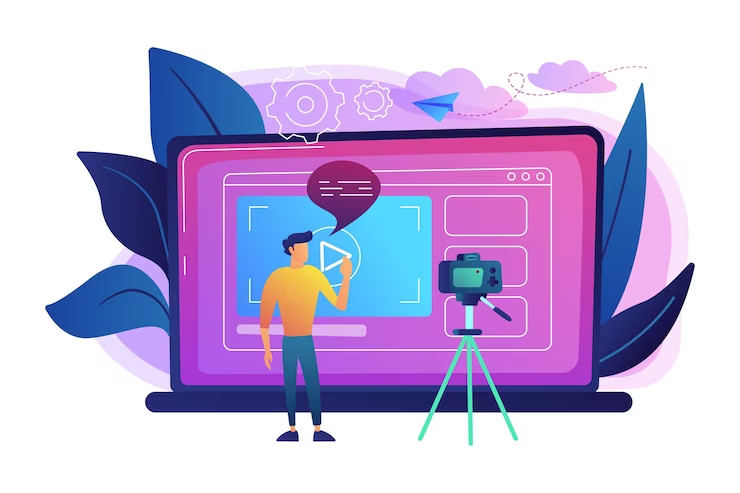Let’s talk visuals! I’m not talking about the back of your cereal box, the side of your milk carton, or that weird picture on the bottom of a box of crackers. I’m talking about visual content strategy. We all know what we think visual content strategy is, but do we? Do you know what it looks like in practice? What it sounds like?
Visual content has become an integral part of marketing strategies in recent years. With the rise of social media and the increasing demand for visual content, businesses that fail to incorporate visual content in their marketing strategies risk falling behind. Visual content will continue to play a crucial role in marketing, and businesses that can effectively incorporate visual content into their marketing strategies will gain a competitive edge.
This blog post will explore the importance of visual content in marketing and provide tips on creating an effective visual content strategy to market your business in 2024.
Visual Content Strategy: What Is It?

Visual content is exploding. It’s not just a trend, either; it’s the future of marketing.
So if you want to get noticed, you must use visuals. But how do you create visual content that will engage your audience without seeming like a cheesy stock photo?
That’s where visual content strategy comes in. Visual content strategy is creating content that tells a story and emotionally engages viewers using photos and videos. An excellent visual content strategy will help your brand stand out from the crowd while being memorable enough for people to share with their friends, which means more exposure for your business!
Example
Picture this: you’ve been thinking about switching your hair colour to a lovely platinum blonde, but when you see yourself in photos after getting it done, all you can see is how much darker it looks next to your skin tone, opposite of what was advertised online.
This is an example of how visual content can make or break an experience, and when it comes to marketing and sales, there are so many more possibilities! Visual content strategy helps you avoid these pitfalls by helping you plan:
- How will they be shared?
- How will they be displayed?
- What kind of images should I use?
Importance Of Visual Content Marketing Strategy
Visual content has become an essential component of any effective marketing strategy. It’s no longer enough to rely solely on written content to engage with your audience.
Social media platforms are increasingly becoming visual-first. Studies have shown that people are much more likely to remember information presented visually than in written form. This means that businesses that use visuals in their social media posts are more likely to get their content shared, which can lead to increased brand awareness and reach.
Visual content also can evoke emotions and connect with your audience more deeply. By using persuasive and catchy visuals, businesses can tap into the emotions of their target audience. Finally, visual content is essential to building a solid brand identity. This can help establish your brand as a recognizable and trustworthy entity, increasing customer loyalty and sales.
Read More: Visual Design | Best Guide for Beginners
What Kind Of Visuals Should Be Included In Articles?

Incorporating visuals into articles is an effective way to make them more engaging, memorable, and shareable. However, not all visuals are created equal, and choosing the right visuals is essential to complement the content and capture the reader’s attention. Here are some examples of the types of visuals that can be included in articles:
1) Images
Including relevant and high-quality images in articles can help break up long blocks of text and make the content more visually appealing. Images can also serve as a visual aid to help readers understand complex ideas and concepts.
2) Screenshots
Take a screenshot of your app and include it in your article. When you include a screenshot in your article, you give readers a visual representation of what they can expect to see if they download the app.
You can also use screenshots in articles to show off new features or changes to an existing product. This can help build excitement around your products and encourage people to check out what’s new!
Read More: How To Choose The Right Content Management System (CMS)?
3) Product Images

Product images are a great way to showcase your products. This is a must if you’re selling something that requires an image of the product. It’s also a good idea to include any imagery to help your reader understand what they’re getting into with your product or service.
4) Memes
Memes are humorous images, videos, or pieces of text that are shared widely on social media. Including relevant and witty memes in articles can help make them more shareable and increase their viral potential.
5) Infographics
Infographics are visual content that uses graphics, charts, and other visual elements to convey complex information in a more digestible format. They effectively present statistics, data, and other information that would be difficult to understand in a text-only format.
6) Videos
Videos are a powerful way to engage readers and bring content to life. They can be used to demonstrate how to do something, showcase a product, or tell a story that’s difficult to express in writing.
7) Illustrations
Illustrations are hand-drawn images that can add a unique and artistic touch to articles. They can visually represent abstract ideas or concepts and add personality and character to the content.
Best Practices For Engaging Visual Content
Visual content has become an essential part of any effective marketing strategy. With the rise of social media and other digital channels, businesses must have a solid visual content strategy to stand out. We have gathered the best practices for creating a successful visual content strategy that engages and persuades your audience.
1) Understand Your Audience
Understanding your audience is the first step in creating a successful visual content strategy. You need to know who they are, what they want, and how they engage with visual content. Conducting market research and analyzing your audience’s behavior and preferences can help you tailor your visual content to their needs and interests.
2) Define Your Brand’s Visual Style
Once you understand your audience, you must define your brand’s visual style. Your visual style should be consistent across all your content, from images to videos and social media posts. It should reflect your brand’s personality, values, and messaging. Consider colour schemes, typography, and imagery when defining your brand’s visual style.
3) Create Original Content

Original content is crucial to a successful visual content strategy. It sets you apart from the competition and creates a unique brand identity. Creating original content can be challenging, but it’s worth the effort. Consider working with professional designers, photographers, and videographers to create original visuals that align with your brand’s visual style.
4) Optimize For Different Channels
Different channels require different types of visual content. For example, the visuals you use on Instagram may differ from those on LinkedIn or your website. Ensure your visual content is optimized for each channel to maximize engagement and reach.
Read More: What is SaaS Business Model? Tips to Optimize Revenue
5) Use Storytelling
Storytelling is a powerful way to engage your audience and make your brand memorable. Use visuals to tell stories that connect with your audience emotionally. Use visuals to create a narrative that resonates with your audience, whether through videos, infographics, or images.
6) Invest In Visual Content Tools
There are many visual content tools available that can help you create engaging and compelling visual content. Consider investing in tools like Canva, Adobe Creative Suite, or Hootsuite to create high-quality images, videos, and graphics. These tools can save time and help you create professional-looking visual content that aligns with your brand’s visual style.
7) Use High-Quality Visuals
High-quality visuals are essential to a successful visual content strategy. Low-quality images, videos, or graphics can damage your brand’s credibility and distract your audience. Ensure that your visuals are high-resolution, well-lit, and focused.
8) Repurpose Content

Creating original visual content can be time-consuming and expensive. Consider repurposing existing content to create new visual content. For example, you can turn blog posts into infographics, social media posts into videos, or images into slideshows. Repurposing content can save you time and help you create visual content that aligns with your brand’s messaging and values.
9) Use User-Generated Content
User-generated content (UGC) is a powerful way to engage your audience and build trust. Encourage your audience to create and share visual content related to your brand. Share UGC on your social media, website, or other marketing channels to show your audience that you value their contributions.
10) Use Data And Insights
Data and insights can help create an informed and compelling visual content strategy. Use analytics tools to track engagement, reach, and other metrics to optimize your visual content strategy. Analyze your data to identify trends, patterns, and insights that can inform your visual content strategy. For example, if you notice that certain types of visual content perform better on specific channels, you can tailor your strategy accordingly.
Read More: Data Visualization Web Design | Best Practices
11) Stay Up-To-Date

Visual content trends are constantly changing. Stay up-to-date with the latest trends in visual content to ensure that your content remains relevant and engaging. Attend industry events, read industry publications, and follow thought leaders in your industry to stay informed.
12) Use Calls-To-Action (CTAs)
Visual content should have a purpose – to drive website traffic, increase sales, or generate leads. Use calls-to-action (CTAs) in your visual content to direct your audience towards the desired action. CTAs should be clear, concise, and easy to understand. Consider using action-oriented words like “download,” “sign-up,” or “subscribe” to encourage your audience to take action.
Tools And Resources To Create High-Quality Visual Content

When creating high-quality visual content for your business, having the right tools and resources can make all the difference. Let’s explore the best tools and resources available to help you create engaging and compelling visual content.
1) Canva
Canva is a popular graphic design platform that offers a wide range of templates, graphics, and design tools. With Canva, you can create everything from social media posts to infographics to business cards. The platform is easy to use without design experience and offers free and paid plans.
2) Adobe Creative Cloud
Adobe Creative Cloud is a suite of design tools that includes Photoshop, Illustrator, InDesign, and more. While these tools require a bit more skill to use than Canva, they offer more advanced features and greater flexibility. Creative Cloud is a subscription-based service, so you’ll need to pay a monthly fee to access the tools.
3) Piktochart
Piktochart is an online platform specialising in creating infographics, presentations, and reports. The platform offers a wide range of templates and design elements, making it easy to create professional-looking visuals quickly. Piktochart offers both free and paid plans.
4) Unsplash
Unsplash is a popular stock photo website that offers a large selection of high-quality images that are free to use. The site is an excellent resource for finding images for your visual content, whether creating social media posts or designing a website.
5) GIPHY
GIPHY is a website and app specialising in creating and sharing animated GIFs. GIFs are a fun and engaging way to add visual interest to your social media posts, blog articles, and emails. GIPHY offers a wide selection of pre-made GIFs and tools for creating your own.
6) Animoto
Animoto is a platform allowing you to quickly and easily create professional-looking videos. The platform offers a range of templates and design tools, making it easy to create videos for social media, email marketing campaigns, and more. Animoto offers both free and paid plans.
7) Easil
Easil is a design platform offering a wide range of templates and design tools, making creating engaging visual content for your business easy. The platform specializes in social media graphics and offers tools for creating flyers, posters, and more. Easil offers both free and paid plans.
Bottom Line
In conclusion, a solid visual content strategy can make all the difference in marketing your business in 2023. Whether you’re creating social media posts, infographics, videos, or other types of visual content, plenty of tools and resources are available to help you create high-quality visuals that resonate with your audience.
Remember, visual content is an integral part of any modern marketing strategy. By investing time and resources into creating high-quality visuals, you can differentiate your business from the competition, build brand awareness, and drive more traffic to your website. So start brainstorming today and see how it can impact your business this year and beyond!
FAQs
How can I create high-quality visual content if I have no design experience?
A variety of tools and resources are available to help you create high-quality visual content even if you have no design experience. Some popular options include Canva, Piktochart, and Easil.
How do I measure the success of my visual content strategy?
The metrics you use to measure success will depend on your goals. Some standard metrics include engagement rates (likes, comments, shares), click-through rates, conversion rates, and overall reach.
How often should I create new visual content for my business?
Your visual content creation frequency will depend on your goals and resources. It’s generally a good idea to create new visual content on a regular basis.
Can I use stock images in my visual content?
Yes, you can use stock images in your visual content. However, ensuring that the images are high-quality and relevant to your brand and message is essential.
